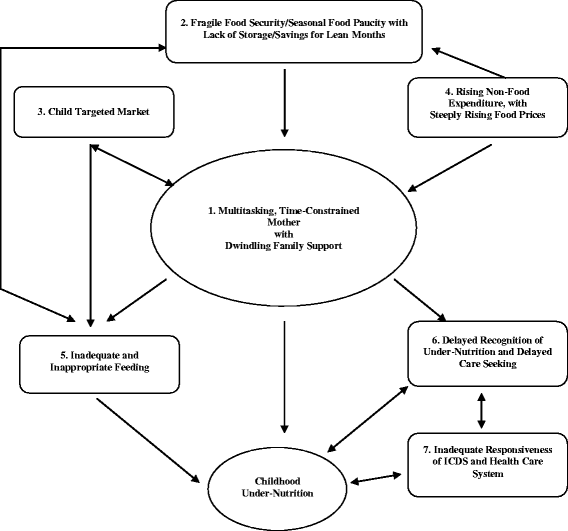Time-constrained mother and expanding market: emerging model of under-nutrition in India
- PMID: 27456223
- PMCID: PMC4960674
- DOI: 10.1186/s12889-016-3189-4
Time-constrained mother and expanding market: emerging model of under-nutrition in India
Abstract
Background: Persistent high levels of under-nutrition in India despite economic growth continue to challenge political leadership and policy makers at the highest level. The present inductive enquiry was conducted to map the perceptions of mothers and other key stakeholders, to identify emerging drivers of childhood under-nutrition.
Methods: We conducted a multi-centric qualitative investigation in six empowered action group states of India. The study sample included 509 in-depth interviews with mothers of undernourished and normal nourished children, policy makers, district level managers, implementer and facilitators. Sixty six focus group discussions and 72 non-formal interactions were conducted in two rounds with primary caretakers of undernourished children, Anganwadi Workers and Auxiliary Nurse Midwives.
Results: Based on the perceptions of the mothers and other key stakeholders, a model evolved inductively showing core themes as drivers of under-nutrition. The most forceful emerging themes were: multitasking, time constrained mother with dwindling family support; fragile food security or seasonal food paucity; child targeted market with wide availability and consumption of ready-to-eat market food items; rising non-food expenditure, in the context of rising food prices; inadequate and inappropriate feeding; delayed recognition of under-nutrition and delayed care seeking; and inadequate responsiveness of health care system and Integrated Child Development Services (ICDS). The study emphasized that the persistence of child malnutrition in India is also tied closely to the high workload and consequent time constraint of mothers who are increasingly pursuing income generating activities and enrolled in paid labour force, without robust institutional support for childcare.
Conclusion: The emerging framework needs to be further tested through mixed and multiple method research approaches to quantify the contribution of time limitation of the mother on the current burden of child under-nutrition.
Keywords: Care-giving; Childhood under-nutrition; Determinants of under-nutrition; Malnutrition; Women’s issues.
Figures


References
-
- Deaton A, Drèze J. Food and Nutrition in India: facts and interpretations. Econ. Polit. Wkly. 2009;44:42–65.
-
- International Institute of Population studies (IIPS) National Family Health Survey (NFHS-3), 2005–06: Mumbai, India. 2007. http://dhsprogram.com/pubs/pdf/FRIND3/FRIND3-Vol1andVol2.pdf. Accessed 9 July 2016.
-
- National Sample Survey. Key indicators of household consumer expenditure in India, 66th round, Ministry of Statistics and Program Implementation, Government of India, 2009–10. Available: http://mospi.nic.in/Mospi_New/upload/Press%20Release%20KI-HCE-66th_8july.... Accessed 29 Dec 2014.
MeSH terms
LinkOut - more resources
Full Text Sources
Other Literature Sources
Medical

